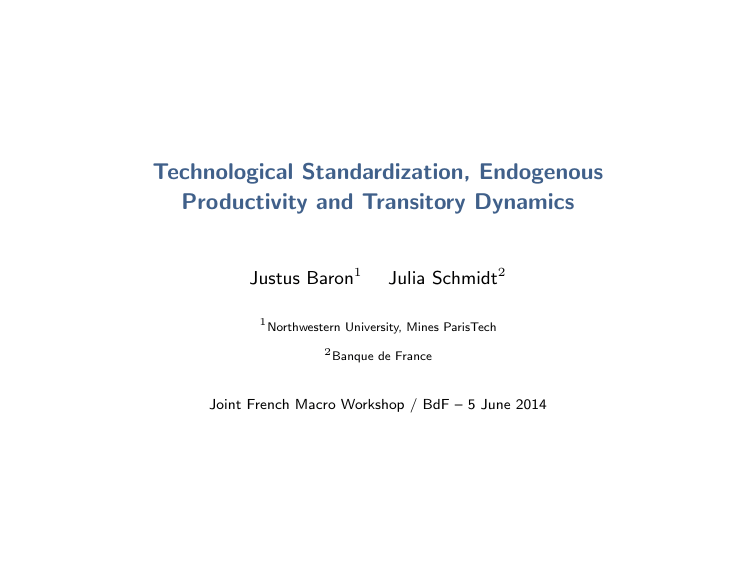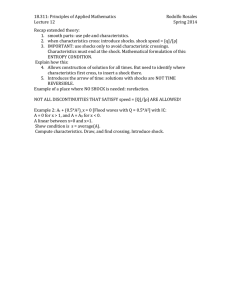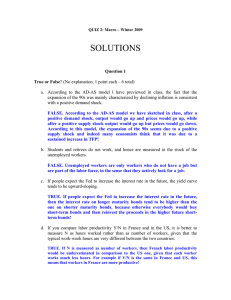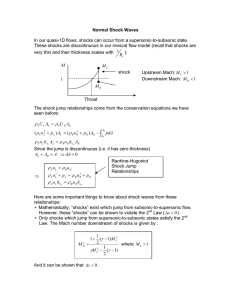Presentation - Banque de France
advertisement

Technological Standardization, Endogenous Productivity and Transitory Dynamics Justus Baron1 1 Julia Schmidt2 Northwestern University, Mines ParisTech 2 Banque de France Joint French Macro Workshop / BdF – 5 June 2014 A never-ending story ... • What drives business cycles? • Technology as a popular explanation for business cycle fluctuations • Question of technology-induced fluctuations remains on the research agenda of macroeconomists due to the difficulty of identifying technology shocks. • Literature on investment-specific technological (IST) change (Greenwood et al., 1988) and “news shocks” (Beaudry and Portier, 2006; Jaimovich and Rebelo, 2009): Revival of role of (embodied) technology for business cycle fluctuations 2/40 Opening the black box of technology shocks • Aggregate macroeconomic movements stem most likely from general purpose technologies (GPTs) • ICT = dominant GPT of the last decades (Basu and Fernald, 2008) 3/40 Opening the black box of technology shocks • Aggregate macroeconomic movements stem most likely from general purpose technologies (GPTs) • ICT = dominant GPT of the last decades (Basu and Fernald, 2008) • Fundamental characteristics of GPTs: • Network externalities • Compatibility requirements → Necessity to agree on a minimal set of rules for all users of the network technology 3/40 Opening the black box of technology shocks • Aggregate macroeconomic movements stem most likely from general purpose technologies (GPTs) • ICT = dominant GPT of the last decades (Basu and Fernald, 2008) • Fundamental characteristics of GPTs: • Network externalities • Compatibility requirements → Necessity to agree on a minimal set of rules for all users of the network technology • Standardization = process of establishing these rules 3/40 The interaction between technology and the cycle Macroeconomics / Business cycle activity Economic incentives Financing opportunities InnovaRandom tive input: + science R&D flow Initial shocks Expectations New Selection Standartechnodization logies Economic incentives Uncertainty reduction Technology diffusion Actual impact on cycle Adoption Commercialization Existing indicators: t R&D expenditures (Shea, 1999) Patents (Shea, 1999) Standards (This paper) Technology books Corrected (Alexopoulos, Solow 2011) residuals (Basu et al, 2006) 4/40 Goal of this paper • Identification of an important microeconomic mechanism which predates technology adoption • Analysis of macroeconomic aggregates’ reaction to technology shocks 5/40 Goal of this paper • Identification of an important microeconomic mechanism which predates technology adoption • Analysis of macroeconomic aggregates’ reaction to technology shocks • Summary of results: 1 Slow diffusion → positive, S-shaped reaction of output and investment Temporary slowdown of disembodied productivity (TFP) 2 Analogy with “news shocks” as stock market indices react positively on impact 5/40 Existing indicators of technology • Derivation of technology shocks using long-run restrictions (Galı́, 1999) • Correction of Solow residuals for capacity utilization, increasing returns, imperfect competition and aggregation effects (Basu et al., 2006) • Relative price of investment goods (Greenwood et al., 2000; Fisher, 2006) • Direct indicators of technology: • Patent data (Shea, 1999; Kogan et al., 2012) • Transfer of ownership of patents (Serrano, 2007) • Technology publications such as manuals (Alexopoulos, 2011) 6/40 What constitutes a good indicator of technology (adoption)? • Central question: What is a technology shock? • Science and technological inventions lead to an expansion of the technology frontier. • However, the shock itself happens when technologies are adopted (= catch-up with the technology frontier). • GPTs: technological/economic necessity to standardize • A technology shock affects all major industries and production processes. 7/40 What constitutes a good indicator of technology (adoption)? • Central question: What is a technology shock? • Science and technological inventions lead to an expansion of the technology frontier. • However, the shock itself happens when technologies are adopted (= catch-up with the technology frontier). • GPTs: technological/economic necessity to standardize • A technology shock affects all major industries and production processes. • A good indicator should ... • ... be closely related to the adoption and commercialization, and not the invention, of a new technology. • ... be relevant in terms of technological and economic significance. • ... be an objective measure and directly linked to technology. 7/40 A novel indicator of technology diffusion • Technological standard = document which describes the required technical features of products and processes • A4 paper size, electricity plugs, quality standards such as ISO 9001, ... → Industry-wide coordination efforts to ensure compatibility of technical devices • Explicit economic mechanism that predates technology implementation • Direct link to point in time when technology is adopted • High technological and economic content of each standard • Use of ICT standards due to the nature of ICT as a general purpose technology (GPT) (Basu and Fernald, 2008) → Analysis of a specific technology shock which is interpreted as one of radical technical change in production processes (i.e. as opposed to political reforms) 8/40 A popular example of standardization • 1G, 2G and 3G represent different standard families in the wireless telecommunications sector 9/40 A popular example of standardization • 1G, 2G and 3G represent different standard families in the wireless telecommunications sector • First generation (1G): analog telecommunications systems (1980’s) 9/40 A popular example of standardization • 1G, 2G and 3G represent different standard families in the wireless telecommunications sector • First generation (1G): analog telecommunications systems (1980’s) • Second generation (2G): digital mobile phone systems in the 1990’s 9/40 A popular example of standardization • 1G, 2G and 3G represent different standard families in the wireless telecommunications sector • First generation (1G): analog telecommunications systems (1980’s) • Second generation (2G): digital mobile phone systems in the 1990’s • Third generation (3G): high speed data transmission and mobile Internet access available as of 2000’s 9/40 A popular example of standardization • 1G, 2G and 3G represent different standard families in the wireless telecommunications sector • First generation (1G): analog telecommunications systems (1980’s) • Second generation (2G): digital mobile phone systems in the 1990’s • Third generation (3G): high speed data transmission and mobile Internet access available as of 2000’s • Forth generation (4G): super high speed... 9/40 Standard setting • Types of standard setting: • De facto: market selection processes, traditional use or monopolistic supply (proprietary standards) • Voluntary/informal: industry organizations (non-proprietary standards) • Formal: standard setting organizations with binding decisions • Standard setting organizations (SSOs): • International: International Organization for Standardization (ISO), International Telecommunication Union (ITU) • Regional: European Telecommunications Standards Institute (ETSI), European Committee for Standardization (CEN) • National: American National Standards Institute (ANSI), Association française de normalisation (AFNOR), Deutsches Institut für Normung (DIN) • > 100,000 standards in the US today developed by > 600 SSOs • US: 90% of all standards are set by the 20 largest SSOs 10/40 Standards data Table 1 : Characteristics by ICS classification 1975Q1–2011Q4 Number Health/safety/environment/agriculture ICT Engineering/electronics Materials technologies Transport/construction Generalities/infrastructures/sciences/etc. Total % new US US Int US US+Int 10 140 9 603 27 772 30 801 30 782 7 432 107 480 20 032 62 753 49 064 41 004 40 108 16 327 209 988 47 68 45 32 46 40 44 51 56 51 37 47 51 49 + 11/40 Figure 1 : Standard series Standards ICT (US) Standards (US) 200 1000 150 750 100 500 50 250 1975 1980 1985 1990 1995 2000 2005 2010 (a) ICT Standards and all standards (US) 200 2000 Standards ICT (US) Standards ICT (US+Int) 1500 150 1000 100 500 50 1975 1980 1985 1990 1995 2000 2005 2010 (b) ICT Standards (US and Int) 12/40 Economic implications of standardization • Compatibility and network effects. Need for compatibility in order to benefit from positive externalities (Katz and Shapiro, 1985, 1986; David and Greenstein, 1990; Farrell and Saloner, 1988). • Economic significance and “lumpy” adoption. Standards comprise several inventions, relate to other standards and are adopted in “bundles”. • Selection mechanism. Choice of one practice among competing ones in order to identify relevant technologies (Rysman and Simcoe, 2008). • Reduction of uncertainty and expectations. Standardization defines the direction towards an industry is heading and anchors technological expectations. • Discontinuous technologies which incentivize incremental innovation. Standards as indicators of radical technological change → Backwards non-compatibility and need for further investment and innovation. • Long-term impact and “QWERTY-nomics” (David, 1985). Network externalities, path dependence and irreversibility of investment make future technology a function of today’s standardization choices. 13/40 Data Quarterly data for the US, 1975Q1-2011Q4 Variable Description Source Standards Number of standards released per quarter by American standard setting organizations ICT sector: ICS classes 33 (Telecommunications) and 35 (Information technology) PERINORM database Macroeconomic variables Business output Non-residential investment in equipment and software Consumption of goods and services Hours worked Capacity utilization Price indices for investment BLS NIPA tables (BEA) NIPA tables (BEA) BLS FRB NIPA tables (BEA) TFP Utilization-adjusted total factor productivity in “investment sector” (equipment and consumer durables) and in “consumption sector” (non-equipment) John Fernald (San Francisco Fed) Stock market indices S&P 500 NASDAQ Composite index Datastream Interest rate Federal Funds rate FRB 14/40 Procyclical standardization (1) Figure 2 : ICT Standards and business output Standards ICT (US) Output 0 0 1975 1980 1985 1990 1995 2000 2005 2010 Notes: Data are in logs, and HP-detrended (with smoothing parameter 1600). Output is seasonally adjusted. Standard data are averaged over a centered window of 9 quarters. Shaded areas correspond to NBER recession dates. 15/40 Procyclical standardization (2) Figure 3 : Cross-correlations of ICT Standards and macro variables Output Investment TFP (adj.) 0.5 0.4 0.3 0.2 0.1 0 −0.1 −0.2 −0.3 −0.4 −0.5 −8 −7 −6 −5 −4 −3 −2 −1 0 1 2 3 4 5 6 7 8 Notes: The x-axis shows quarters and the y axis the estimated cross-correlations. Cross-correlations were calculated based on the data which are in logs, seasonally adjusted and HP-detrended. Standard data are averaged over a centered window of 5 quarters.) The above graph shows that standards are lagging output and investment. 16/40 Procyclicality (3) • Idea: check procyclicality in a VAR framework using an agnostic business cycle shock • Variables in baseline VAR: Output, Investment, TFP, Standards • Business cycle shock: • Identification based on Giannone et al. (2012a) who modify the approach of DiCecio and Owyang (2010) • Extraction of a shock process which is a linear combination of all the shocks in the VAR system (except the technology shock) that leads to a high variation in output at business cycle frequencies • Identification of the technology shock is left unchanged Details 17/40 Figure 4 : IRFs: Business cycle shock Output Investment 0.012 0.025 0.01 0.02 0.015 0.008 0.01 0.006 0.005 0.004 0 0.002 −0.005 0 4 12 −0.01 16 x 10 8 12 16 12 16 Standards 0.06 5 0.04 4 0.02 3 0 2 −0.02 1 −0.04 0 4 TFP −3 6 8 4 8 12 −0.06 16 US 4 8 US+Int 18/40 Econometric approach • What do we know about technology from innovation economics? • Procyclicality/endogeneity → Use of vector autoregressions • Slow technology diffusion (Griliches, 1957; Comin and Hobijn, 2010) 19/40 Econometric approach • What do we know about technology from innovation economics? • Procyclicality/endogeneity → Use of vector autoregressions • Slow technology diffusion (Griliches, 1957; Comin and Hobijn, 2010) • How to tackle slow diffusion? → Not trivial to deal with macroeconometrically (Lippi and Reichlin, 1993) → Use of meaningful information to capture the point in time when a technology is adopted or its future adoption is announced → Lag truncation bias (Ravenna, 2007; Chari et al., 2008) 19/40 A BVAR that accounts for diffusion lags (1) • Slow technology diffusion requires the use of long lags → high estimation uncertainty • Bayesian shrinkage deals with overparameterization by combining the likelihood of the data with informative priors • Minnesota prior where prior coefficients aijl approximate the time series behaviour of the data aijl = δi 0 if i = j and s = 1 otherwise • δi = 1 (unit root behaviour) for macroeconomic variables • δi = 0 (substantial mean reversion) for standards 20/40 A BVAR that accounts for diffusion lags (2) • Bayesian VAR approach in order to allow for a large number of lags and a differentiated lag structure among the variables in the VAR • Informativeness of the prior: φ1 for i = j, i 6= k, l = 1, . . . , p (own lags) φ4 lφ φ σ 2 1 2 i V aijl = for i = 6 j, i 6= k, l = 1, . . . , p (lags of other variables) lφ4,j σ 2 j 2 φ3 σi for the constant 21/40 A BVAR that accounts for diffusion lags (3) • Choice of hyperparameters: • Quadratic lag decay (φ4,j = 2) and uninformative prior for the constant • Long lags of the standard series s are “allowed to speak”: φ4,s = 0 • Symmetric treatment of all equations (Kadiyala and Karlsson, 1997; Sims and Zha, 1998) → φ2 = 1 • Overall prior variance: φ1 is estimated from the data by maximizing the marginal likelihood of the model (empirical Bayes method following Canova, Technical details 2007; Giannone et al., 2012b; Carriero et al., 2011) • Posterior simulations using the Normal-Wishart prior (implemented using dummy observations) in order to allow for a non-diagonal variance-covariance matrix and compute IRFs 22/40 Table 2 : Estimated lag decay parameters (a) Standard series used: US Implied decay at different lags φ4,j Output Investment TFP (adj.) Standards 0.6990 1.0721 0.8707 0.5083 4 8 12 2.6 4.4 3.3 2.0 4.3 9.3 6.1 2.9 5.7 14.4 8.7 3.5 (b) Standard series used: US and Int Implied decay at different lags φ4,j Output Investment TFP (adj.) Standards 0.4023 0.6384 0.4935 0.0777 4 8 12 1.7 2.4 2.0 1.1 2.3 3.8 2.8 1.2 2.7 4.9 3.4 1.2 23/40 Identification of the technology shock • Variables in baseline VAR: Output, Investment, TFP, Standards • Technology shock: • Cholesky decomposition • Ordering: Output, investment, TFP and standards • Similar to Shea (1999) • Idea: Standardization is the first step in the adoption of a new technology, necessity to invest in incremental innovation before actual commercialization 24/40 Figure 5 : IRFs: Responses to a technology shock Output −3 15 x 10 Investment 0.025 0.02 10 0.015 5 0.01 0.005 0 0 −5 8 24 32 8 TFP (adj.) −3 6 16 −0.005 x 10 16 24 32 24 32 Standards 0.35 0.3 4 0.25 2 0.2 0 0.15 0.1 −2 −4 0.05 8 16 24 0 32 US 8 16 US+Int Beaudry and Portier (2006) 25/40 S-shaped technology diffusion • Empirical evidence of diffusion patterns starting with Griliches (1957) show that technology diffusion follows a logistic curve. Figure 6 : Diffusion of consumer goods Source: New York Times (2008) 25/40 Figure 7 : IRFs: Responses to a technology shock Output −3 15 x 10 Investment 0.025 0.02 10 0.015 5 0.01 0.005 0 0 −5 8 24 32 8 TFP (adj.) −3 6 16 −0.005 x 10 16 24 32 24 32 Standards 0.35 0.3 4 0.25 2 0.2 0 0.15 0.1 −2 −4 0.05 8 16 24 0 32 US 8 16 US+Int Beaudry and Portier (2006) 25/40 Are we picking up the right stuff? • Add sectoral measures of investment one by one • Estimation of a block exogeneity VAR to ensure consistent estimation of technology shock 26/40 Table 3 : Impact of a technology shock, IRF at horizon 20 Investment series Equipment a Information processing equipment aaa Computers and periphal equipment aaa Other information processing equipment a Industrial equipment a Transportation equipment a Other equipment Intellectual property products a Software a Research and development a Entertainment, literary, and artistic originals US US+Int 0.93* 1.59* 3.59* 0.61* 0.42* 0.72* 0.44* 1.11* 2.74* 0.52* 0.58* 0.82* 1.40* 2.78* 0.62* 0.39* 0.45 0.75* 0.71* 1.81* 0.02 0.46* “*” denotes significance at the 5th/95th percentile. 27/40 Table 4 : Variance decompositions at different frequencies (a) Standard series used: US Business cycle shock Technology shock Frequency (quarters) 8–32 33–200 8–32 33–200 Output Investment TFP (adj.) Standards 0.47 0.27 0.21 0.07 0.17 0.10 0.13 0.07 0.06 0.05 0.06 0.68 0.19 0.14 0.14 0.26 (b) Standard series used: US and Int Business cycle shock Technology shock Frequency (quarters) 8–32 33–200 8–32 33–200 Output Investment TFP (adj.) Standards 0.58 0.43 0.18 0.08 0.20 0.17 0.15 0.11 0.05 0.05 0.06 0.75 0.16 0.11 0.11 0.18 28/40 Figure 8 : Variance decompositions for different frequencies (US) Business cycle shock → Standards Technology shock → Macro variables 0.16 0.25 Output Investment TFP (adj.) Share of variance decomposition Share of variance decomposition 0.14 0.12 0.1 0.08 0.06 0.04 0.2 0.15 0.1 0.05 0.02 0 0 0.4 0.8 Frequency 1.2 0 0 0.4 0.8 Frequency 1.2 29/40 Figure 9 : Variance decompositions for different frequencies (US+Int) Technology shock → Macro variables 0.2 0.18 0.18 Share of variance decomposition Share of variance decomposition Business cycle shock → Standards 0.2 0.16 0.14 0.12 0.1 0.08 0.06 0.04 0.02 0 Output Investment TFP (adj.) 0.16 0.14 0.12 0.1 0.08 0.06 0.04 0.02 0 0.4 0.8 Frequency 1.2 0 0 0.4 0.8 Frequency 1.2 30/40 Technological change and expectations • Slow technology diffusion leads to the effects of a shock materializing only with a considerable delay • Technology shocks identified from standardization data could show similar patterns as “news shocks”. • Do results hold when stock market data are included? • S&P500 • NASDAQ Composite index 31/40 Figure 10 : IRFs: Responses to a technology shock and news Output −3 12 x 10 Investment −3 20 10 x 10 TFP (adj.) −3 6 15 4 6 10 2 4 5 0 0 −2 x 10 8 2 0 −2 −5 8 16 24 32 −4 8 Standards 16 24 32 8 S&P500 0.35 0.05 0.3 0.04 16 24 32 NASDAQ 0.06 0.04 0.25 0.03 0.2 0.02 0.02 0.15 0.01 0.1 0 0 0.05 0 −0.01 8 16 24 32 −0.02 8 16 US 24 32 8 16 24 32 US+Int 32/40 Robustness — Weighting standards by their relative importance 1 Pages • Every line of text that is added to a standard represents a compromise • Lengthy standard = indicator of the complexity of the technology 2 References • Referencing = explicit link to an already existing standards by ulterior standard documents • Referenced standard = technological importance • Window: 4 years (→ only use of data up to 2009) • Weighting schemes follow Trajtenberg (1990) who constructs citation-weighted patent counts WSCxt = nt X (1 + xi,t ) where x = p, r (1) i=1 33/40 Figure 11 : Weighting standard counts Output Investment 0.03 0.025 Output 0.04 0.018 0.035 0.016 0.03 0.014 0.025 0.012 Investment 0.035 0.03 0.025 0.02 0.02 0.015 0.02 0.01 0.01 0.015 0.008 0.01 0.006 0.005 0.004 0 0.002 0.015 0.01 0.005 0 −0.005 −0.005 8 16 24 32 16 24 8 6 0.9 5 16 24 32 x 10 16 24 32 24 32 Standards 1 0.9 0.8 4 0.7 8 TFP (adj.) −3 1 0.8 0 −0.005 32 Standards 0.005 0 0 8 TFP (adj.) 0.01 0.005 0.7 3 0.6 0.6 2 0.5 0.5 1 −0.005 0.4 0.4 0 0.3 −0.01 −0.015 8 16 US baseline 24 0.1 −2 0 −3 32 US Page−weighted 0.3 −1 0.2 8 16 24 US Reference−weighted (a) Standard series used: US 32 0.2 0.1 0 8 16 US+Int baseline 24 32 US+Int Page−weighted 8 16 US+Int Reference−weighted (b) Standard series used: US and Int 34/40 Robustness — Radical vs. incremental innovation • A substantial number of standard in our dataset consist of upgraded versions of already existing standards 35/40 Robustness — Radical vs. incremental innovation • A substantial number of standard in our dataset consist of upgraded versions of already existing standards • Radical innovation: Series which excludes upgraded versions of prior released standards from our standard count • Incremental innovation: Series which only consists of upgraded versions 35/40 Figure 12 : Radical vs. incremental innovation Output Investment 0.025 0.035 0.03 0.02 0.025 0.015 0.02 0.01 0.015 0.005 0.01 0 0.005 −0.005 0 8 24 32 8 TFP (adj.) −3 10 16 x 10 16 24 32 24 32 Standards 1 0.9 8 0.8 6 0.7 4 0.6 2 0.5 0 0.4 −2 0.3 −4 0.2 −6 0.1 −8 0 8 16 US radical 24 32 US+Int radical 8 US incremental 16 US+Int incremental 36/40 Robustness — Larger VAR system • Additional variables: Consumption, Hours worked, Capacity utilization, TFP in the consumption sector, Relative price of investment, Federal Funds rate • Identification as before: Technology shocks impact contemporaneously only on standardization and stock market indices 37/40 Figure 13 : IRFs from large system 15 x 10 −3 Output Investment 0.03 15 10 0.02 10 5 0.01 5 0 0 0 x 10 −3 −3 Consumption 10 Hours x 10 5 0 −5 −0.01 8 16 24 −5 32 8 −3 Capacity util. 0.6 15 0.4 x 10 16 24 −5 32 8 TFP (adj.) Inv. 3 x 10 16 24 32 TFP (adj.) Cons. 10 16 24 32 Rel. price Inv. 0.01 2 0.2 8 −3 0.005 1 0 0 −0.005 5 0 0 −0.2 −0.4 −5 8 16 24 32 8 Fed funds rate 16 24 −1 −0.01 −2 −0.015 32 8 Standards 0.4 0.2 16 24 32 8 S&P500 16 24 32 24 32 NASDAQ 0.4 0.08 0.08 0.3 0.06 0.06 0.2 0.04 0.04 0.1 0.02 0.02 0 0 0 −0.1 −0.02 −0.02 0 −0.2 −0.4 8 16 24 32 8 16 24 32 US 8 US+Int 16 24 32 8 16 38/40 Some more robustness • Inclusion of more standard classes (ICS 31: Electronics / ICS 37: Image technology) Figure • Replacement of ICT standards with standards from other sectors (manufacturing, services, ...) • Responses are similar, but muted and more often insignificant 39/40 Summary of results and conclusions • Caution: Technology adoption is cycle-driven (especially at lower frequencies) 40/40 Summary of results and conclusions • Caution: Technology adoption is cycle-driven (especially at lower frequencies) 1 Positive impact of technology shocks on the cycle • S-shaped technology diffusion • Rich transitory dynamics of disembodied productivity → Reconciliation of the fact that productivity slowdowns are observed in the data with the notion of an ever-evolving technology frontier. 2 Propagation of our identified technology shock shows a similar pattern as the one of “news shocks” (due to slow technological diffusion). 40/40 Summary of results and conclusions • Caution: Technology adoption is cycle-driven (especially at lower frequencies) 1 Positive impact of technology shocks on the cycle • S-shaped technology diffusion • Rich transitory dynamics of disembodied productivity → Reconciliation of the fact that productivity slowdowns are observed in the data with the notion of an ever-evolving technology frontier. 2 Propagation of our identified technology shock shows a similar pattern as the one of “news shocks” (due to slow technological diffusion). • Need to understand technology and productivity as multifaceted phenomena • Importance of analyzing the microeconomic mechanisms that are at the basis of the driving forces of macroeconomic fluctuations 40/40 Identification of a business cycle shock (1) • Notation follows largely Altig et al. (2005). • Reduced form VAR: Yt = A(L)Yt + ut • Structural VAR: B0 Yt = B1 Yt−1 + B2 Yt−2 + . . . + Bp Yt−p + εt Yt = [I − A(L)]−1 CRR−1 C −1 ut = [I − A(L)]−1 CRε∗t where A(L) = (B0 )−1 B(L) , C = (B0 )−1 and ε∗t = R−1 C −1 ut • Implementation: a set of column vectors of C is rotated by R so that the shock εj,t maximizes the forecast error variance of one of the variables Yk,t of the vector Yt at business cycle frequencies • Variance of Yt in the time domain: −1 E[Yt Yt0 ] = [I − A(L)]−1 CRR0 C 0 I − A(L)0 40/40 Identification of a business cycle shock (2) • Use of variances in the frequency domain • Spectral density of the vector Yt : h i−1 h i−1 SY (e−iω ) = I − A(e−iω ) CRR0 C 0 I − A(e−iω )0 • Spectral density of Yt due to shock εt,j : h i−1 h i−1 SY,j (e−iω ) = I − A(e−iω ) CRIj R0 C 0 I − A(e−iω )0 • Identification → Find R which maximizes the share of the forecast error variance of variable Yk,t due to shock εt,j : Rb SY,j (e−iω )dω 2π 2π Vk,j = ι0k Rab ιk where a = , b= −iω )dω 32 8 S (e Y a Jump back 40/40 Results from Beaudry and Portier (2006) Jump back 40/40 Figure 14 : Historical decomposition of TFP (adj.) (US) 0.02 0.01 0 −0.01 Original data Only business cycle shocks (corr. with original: 0.47) Only technology shocks (corr. with original: 0.36) −0.02 −0.03 1985 1990 1995 2000 2005 2010 Jump back 40/40 Figure 15 : Historical decomposition of TFP (adj.) (US+Int) 0.02 0.01 0 −0.01 Original data Only business cycle shocks (corr. with original: 0.36) Only technology shocks (corr. with original: 0.45) −0.02 −0.03 1985 1990 1995 2000 2005 2010 Jump back 40/40 Technical details on ML • β . . . vectorized VAR coefficients • Σ . . . variance-covariance matrix of residuals of VAR model • Prior distributions: Σ ∼ IW(Ψ, d) β | Σ ∼ N (b, Σ ⊗ Ω) • Marginal likelihood: Z Z p(Y | β, Σ) p(β | Σ) p(Σ) dβ dΣ p(Y ) = • Prior parameters β and Σ depend on a set of hyperparameters Θ • Empirical Bayes method to estimate Θ from the data: Θ∗ = arg max ln p(Y ) Θ Jump back 40/40 Figure 16 : IRFs: Different standard measures 6 x 10 −3 Output Investment 0.015 4 5 0.01 2 0.005 x 10 −3 −3 Consumption 5 4 4 3 3 2 2 1 0 0 8 4 x 10 −3 16 24 8 −3 Capacity util. 6 3 1 0 32 16 24 0 32 8 TFP (adj.) I x 10 1 4 0.5 2 0 0 −0.5 Hours x 10 x 10 −3 16 24 32 8 −3 TFP (adj.) C 2 x 10 16 24 32 Rel. price of I 0 2 1 −2 0 −1 −2 8 16 24 32 −1 8 Fed funds rate 16 24 32 −4 8 Standards 0.2 24 32 8 NASDAQ 0.8 16 24 32 24 32 S&P500 0.04 0.6 0.1 16 0.03 0.03 0.02 0.4 0 0.02 0.2 −0.1 0.01 0.01 0 −0.2 −0.2 8 16 24 32 US ICT (33−35) 0 8 16 24 Intl ICT (33−35) 32 0 8 16 US ICT+Electronics (31−37) 24 32 8 16 Intl ICT+Electronics (31−37) 40/40





